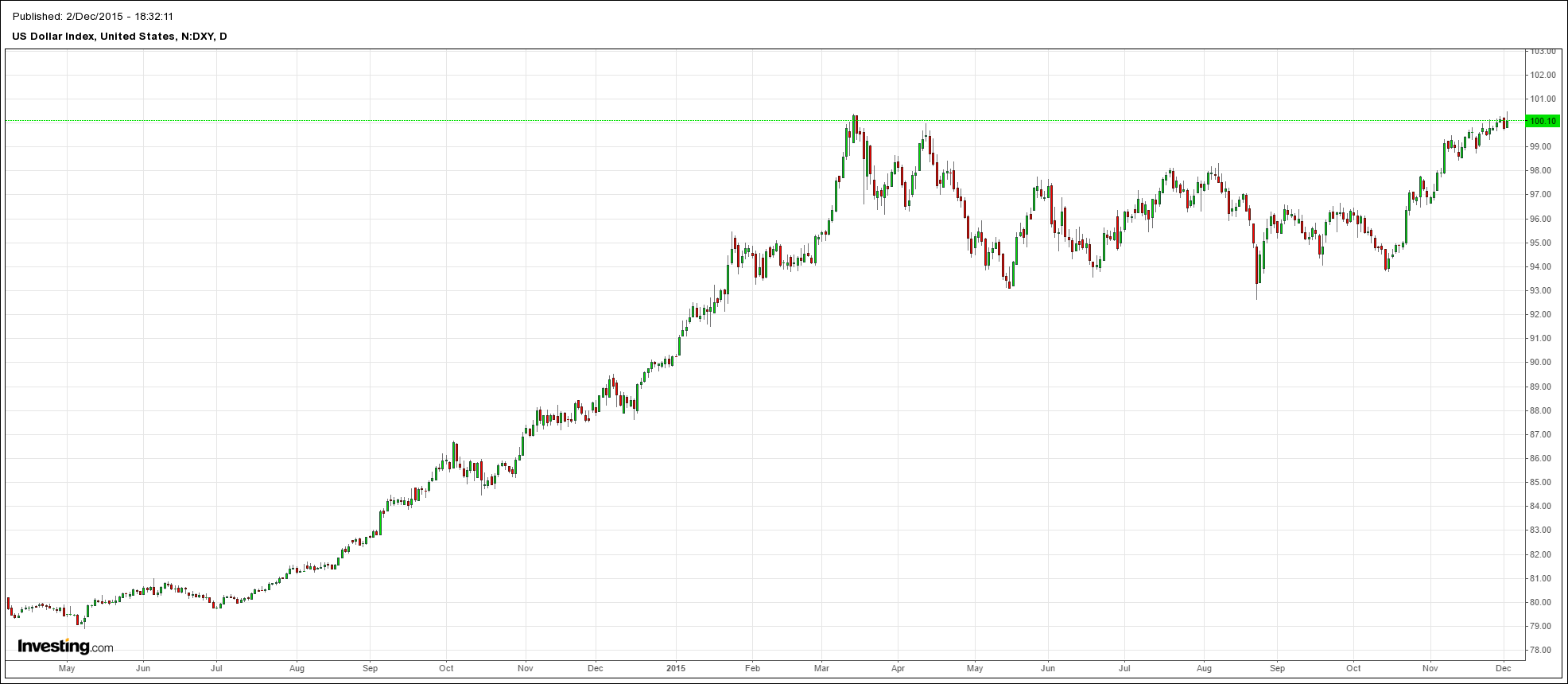From FOMC chair Janet Yellen overnight:
Let me now turn to where I see the economy is likely headed over the next several years. To summarize, I anticipate continued economic growth at a moderate pace that will be sufficient to generate additional increases in employment, further reductions in the remaining margins of labor market slack, and a rise in inflation to our 2 percent objective. I expect that the fundamental factors supporting domestic spending that I have enumerated today will continue to do so, while the drag from some of the factors that have been weighing on economic growth should begin to lessen next year. Although the economic outlook, as always, is uncertain, I currently see the risks to the outlook for economic activity and the labor market as very close to balanced.
Turning to the factors that have been holding down growth, as I already noted, the higher foreign exchange value of the dollar, as well as weak growth in some foreign economies, has restrained the demand for U.S. exports over the past year. In addition, lower crude oil prices have reduced activity in the domestic oil sector. I anticipate that the drag on U.S. economic growth from these factors will diminish in the next couple of years as the global economy improves and the adjustment to prior declines in oil prices is completed.
Although developments in foreign economies still pose risks to U.S. economic growth that we are monitoring, these downside risks from abroad have lessened since late summer. Among emerging market economies, recent data support the view that the slowdown in the Chinese economy, which has received considerable attention, will likely continue to be modest and gradual. China has taken actions to stimulate its economy this year and could do more if necessary. A number of other emerging market economies have eased monetary and fiscal policy this year, and economic activity in these economies has improved of late. Accommodative monetary policy is also supporting economic growth in the advanced economies. A pickup in demand in many advanced economies and a stabilization in commodity prices should, in turn, boost the growth prospects of emerging market economies.
A final positive development for the outlook that I will mention relates to fiscal policy. This year the effect of federal fiscal policy on real GDP growth has been roughly neutral, in contrast to earlier years in which the expiration of stimulus programs and fiscal policy actions to reduce the federal budget deficit created significant drags on growth. Also, the budget situation for many state and local governments has improved as the economic expansion has increased the revenues of these governments, allowing them to increase their hiring and spending after a number of years of cuts in the wake of the Great Recession. Looking ahead, I anticipate that total real government purchases of goods and services should have a modest positive effect on economic growth over the next few years.
Regarding U.S. inflation, I anticipate that the drag from the large declines in prices for crude oil and imports over the past year and a half will diminish next year. With less downward pressure on inflation from these factors and some upward pressure from a further tightening in U.S. labor and product markets, I expect inflation to move up to the FOMC’s 2 percent objective over the next few years. Of course, inflation expectations play an important role in the inflation process, and my forecast of a return to our 2 percent objective over the medium term relies on a judgment that longer-term inflation expectations remain reasonably well anchored. In this regard, recent measures from the Survey of Professional Forecasters, the Blue Chip Economic Indicators, and the Survey of Primary Dealers have continued to be generally stable. The measure of longer-term inflation expectations from the University of Michigan Surveys of Consumers, in contrast, has lately edged below its typical range in recent years. However, this measure often seems to respond modestly, though temporarily, to large changes in actual inflation, and the very low readings on headline inflation over the past year may help explain some of the recent decline in the Michigan measure.6 Market-based measures of inflation compensation have moved up some in recent weeks after declining to historically low levels earlier in the fall. While the low level of these measures appears to reflect, at least in part, changes in risk and liquidity premiums, we will continue to monitor this development closely. Convincing evidence that longer-term inflation expectations have moved lower would be a concern because declines in consumer and business expectations about inflation could put downward pressure on actual inflation, making the attainment of our 2 percent inflation goal more difficult.
Also, the ADP employment report was firm:
Private sector employment increased by 217,000 jobs from October to November according to the November ADP National Employment Report®.
…Goods-producing employment rose by 13,000 jobs in November, down from 22,000 the previous month. The construction industry added 16,000 jobs after gaining over 30,000 in each of the two previous months. Meanwhile, manufacturing rebounded from two straight months of shedding jobs to add 6,000 in November.
Service-providing employment rose by 204,000 jobs in November, a strong increase from an upwardly revised 174,000 in October. …
Mark Zandi, chief economist of Moody’s Analytics, said, “Job growth remains strong and steady. The current pace of job creation is twice that needed to absorb growth in the working age population. The economy is fast approaching full employment and will be there no later than next summer.”
Rubbish. Nonetheless, it’s a good report given expectations were for 187k. Though it must be remembered that ADP is not a very good leading indicator for the BLS.
The double barrel shot the US dollar to a twelve year high, though it could not hold it:

She’s gonna do it…

